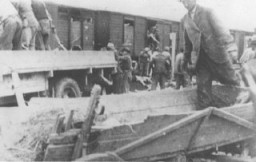You searched for: seo7天上首頁【TG飞机:@bapingseo】谷歌推广必备软件【TG电报:@bapingseo】斯里兰卡google优化【Telegram:@bapingseo】30个娱乐平台网站下载MG游戏中心官方下载?kS0sCe/Bi0r2K.html
<< Previous | Displaying results 51-100 of 396 for "seo7天上首頁【TG飞机:@bapingseo】谷歌推广必备软件【TG电报:@bapingseo】斯里兰卡google优化【Telegram:@bapingseo】30个娱乐平台网站下载MG游戏中心官方下载?kS0sCe/Bi0r2K.html" | Next >>
-
Marie Doležalová testifies
PhotoFifteen-year-old Marie Doležalová testifies for the prosecution at the RuSHA Trial. She was one of the children kidnapped by the Germans after they destroyed the town of Lidice, Czechoslovakia, in June 1942. Nuremberg, Germany, October 30, 1947.

-
Preparing to testify
PhotoFifteen-year-old Maria Dolezalova is sworn in as a prosecution witness at the RuSHA Trial. Dolezalova was among the children kidnapped by German forces after they destroyed the town of Lidice, Czechoslovakia. Nuremberg, October 30, 1947.
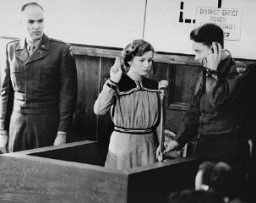
-
Adolf Hitler after being sworn in as chancellor
PhotoGermans cheer Adolf Hitler as he leaves the Hotel Kaiserhof just after being sworn in as chancellor. Berlin, Germany, January 30, 1933.
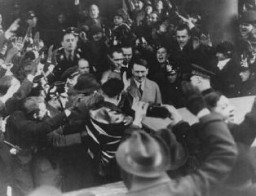
-
Deportation of Jews from Hanau to Theresienstadt
PhotoDeportation of Jews from Hanau, near Frankfurt am Main, to the Theresienstadt ghetto. Hanau, Germany, May 30, 1942.

-
German troops parade through Warsaw
PhotoGerman troops parade through Warsaw after the German invasion of Poland. Warsaw, Poland, September 28-30, 1939.
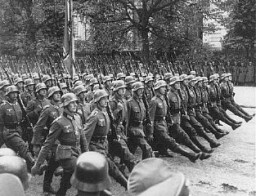
-
Aron in Howard's men's clothing store
PhotoAron standing in Howard's men's clothing store (named for his eldest son) at 9125 Commercial Avenue in Chicago. He opened the store in 1949 and owned it for 30 years. Chicago, Illinois, early 1970s.

-
Aron standing in Howard's men's clothing store
PhotoAron standing in Howard's men's clothing store (named for his eldest son) at 9125 Commercial Avenue in Chicago. He opened the store in 1949 and owned it for 30 years. Chicago, Illinois, early 1970s.

-
Ernest Hemingway
ArticleErnest Hemingway was a legendary American author. In 1933, his classic novel, "A Farewell to Arms," was burned under the Nazi regime. Learn more.
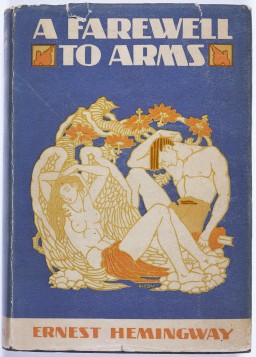
-
August Bebel
ArticleAugust Bebel was a German socialist and founder of the Social Democratic Workers’ Party. His work was burned during the Nazi book burnings of 1933. Learn more.
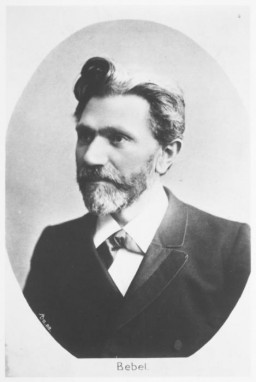
-
Otto Dix
ArticleOtto Dix was a German artist who depicted the horrors of war. His art was targeted in the Nazi book burnings and “Degenerate Art” exhibition. Learn more.
-
Louis Fischer
ArticleLouis Fischer was an American political historian. In May 1933, his work was burned in Nazi Germany for its sympathy toward Communism. Learn more.
-
Benjamin Barr Lindsey
ArticleBenjamin Barr Lindsey was an American judge and champion of progressive causes. His works were among those burned under the Nazi regime in 1933. Learn more.

-
Sigrid Undset
ArticleSigrid Undset was a Norwegian author who won the Nobel Prize for Literature. In part because of her criticism of the Nazi regime, her work was burned in 1933.
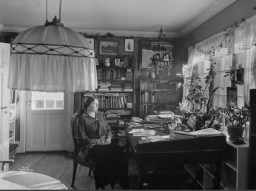
-
Leon Trotsky
ArticleLeon Trotsky was a communist and close associate of Vladimir Lenin. His works were burned in the Nazi book burnings of May 1933. Learn more.
-
Paul Klee
ArticlePaul Klee was a German-Swiss painter and graphic artist who taught at the Bauhaus. His art was targeted in the Nazi book burnings and “Degenerate Art” exhibition.
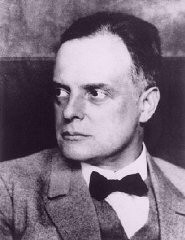
-
David Bromberg poses at the Ebensee displaced persons camp
PhotoJewish DP David Bromberg poses at the entrance to a barrack in the Ebensee displaced persons camp on October 30, 1946.
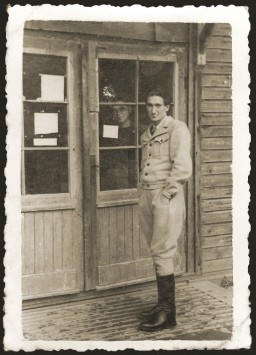
-
Hitler Commits Suicide
Timeline EventApril 30, 1945. On this date, Adolf Hitler committed suicide in his Berlin bunker.
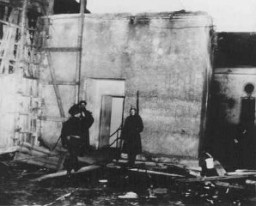
-
Chamberlain, Hitler, and Daladier meet in Munich
PhotoBritish prime minister Neville Chamberlain (left), German chancellor Adolf Hitler (center), and French premier Edouard Daladier (right) meet in Munich to determine the fate of Czechoslovakia. Germany, September 30, 1938.
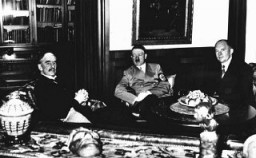
-
Polish Jews in Lithuania: Escape to Japan
ArticleAfter 1940, Polish refugees were pressured to leave Lithuania. Learn more about the diplomats that assisted them and their journey to Japan.
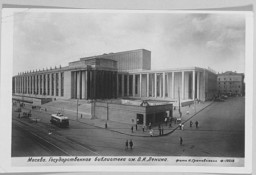
-
Eleanor Roosevelt
ArticleEleanor Roosevelt, longest serving First Lady in US history, used her social and political influence to intervene on behalf of refugees before and during WWII.
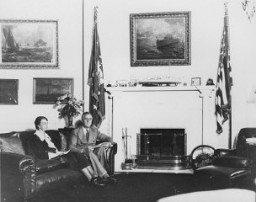
-
Denmark
ArticleLearn about the Jewish population of Denmark, the German occupation, and resistance and rescue in Denmark during WWII and the Holocaust.

-
1941: Key Dates
ArticleExplore a timeline of key events during 1941 in the history of Nazi Germany, World War II, and the Holocaust.
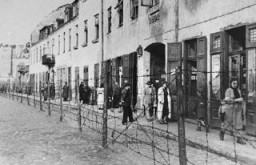
-
Third Reich
ArticleThe “Third Reich” is another name for Nazi Germany between 1933-1945. Learn more about life under Nazi rule before and during World War II.
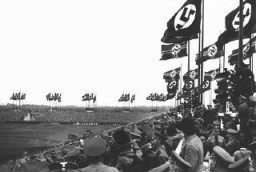
-
Adolf Hitler: 1930-1933
ArticleUnder Adolf Hitler's leadership, the Nazi regime was responsible for the mass murder of 6 million Jews and millions of other victims. Learn about Hitler in the years 1930-1933.
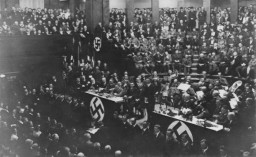
-
Adolf Hitler: Key Dates
ArticleLearn about some key dates in the life of Adolf Hitler, one of Europe's most ruthless dictators, who led the Nazis from 1921 and Germany from 1933-45.

-
World War II Dates and Timeline
ArticleWorld War II was the largest and most destructive conflict in history. Learn about key WWII dates in this timeline of events, including when WW2 started and ended.

-
Law on the Head of State of the German Reich
ArticleThe Law on the Head of State of the German Reich was the last step in destroying democracy in interwar Germany and making Adolf Hitler a dictator. Learn more.
-
Adolf Eichmann: Key Dates
ArticleAdolf Eichmann was a key figure in implementing the “Final Solution,” the Nazi plan to kill Europe's Jews. Learn more through key dates and events.

-
Nazi Rule
ArticleAfter they rose to power in 1933, Hitler and the Nazis eliminated democratic freedoms and took control of all aspects of public life in Germany. Learn more.

-
1938: Key Dates
ArticleExplore a timeline of key events in the history of Nazi Germany during 1938.

-
Althammer
ArticleThe Germans established the Althammer camp in September 1944. It was a subcamp of Auschwitz. Read more about the camp's history and conditions there.
-
The 84th Infantry Division during World War II
ArticleThe 84th Infantry Division participated in major WWII campaigns and is recognized for liberating two Neuengamme subcamps, Hannover-Ahlem and Salzwedel, in 1945.
-
Haviva Reik
Media EssayHaviva Reik was one of 32 Jewish parachutists from Palestine who volunteered to join the British army and infiltrate German-occupied Europe. Reik was sent to Slovakia on a mission to aid Jews during the Slovak nationa...
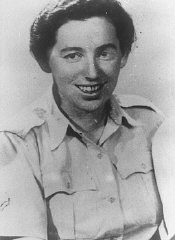
-
Lodz ghetto
FilmThe German army occupied Lodz, Poland, in September 1939. From early February 1940, Jews in Lodz were forced to move to a designated ghetto area, which was sealed on April 30, 1940. This German footage illustrates conditions during winter in the Lodz ghetto. Winter in the ghettos aggravated existing hardships, depleting already sparse supplies of food and fuel.
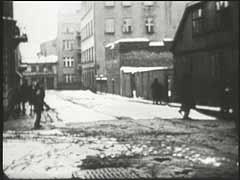
-
Conditions in the Warsaw ghetto
FilmThe Nazis sealed the Warsaw ghetto in mid-November 1940. German-induced overcrowding and food shortages led to an extremely high mortality rate in the ghetto. Almost 30 percent of the population of Warsaw was packed into 2.4 percent of the city's area. The Germans set a food ration for Jews at just 181 calories a day. By August 1941, more than 5,000 people a month succumbed to starvation and disease.
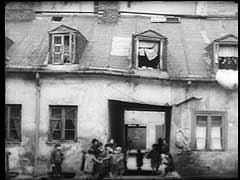
-
Conditions in the Warsaw ghetto
FilmThe Nazis sealed the Warsaw ghetto in mid-November 1940. German-induced overcrowding and food shortages led to an extremely high mortality rate in the ghetto. Almost 30 percent of the population of Warsaw was packed into 2.4 percent of the city's area. The Germans set a food ration for Jews at just 181 calories a day. By August 1941, more than 5,000 people a month succumbed to starvation and disease.
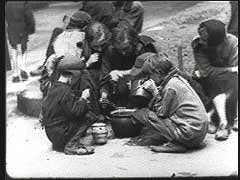
-
Lion Feuchtwanger in New York
PhotoAuthor Lion Feuchtwanger in New York, November 17, 1932. Feuchtwanger's 1930 novel Erfolg (Success) provided a thinly veiled criticism of the Beer Hall Putsch and Hitler's rise to leadership in the Nazi Party. He was targeted by the Nazis. After the Nazi takeover on January 30, 1933, his house in Berlin was illegally searched and his library was plundered during his lecture tour in the United States.
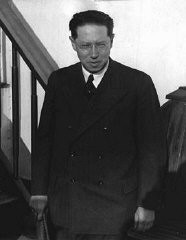
-
Ernest Hemingway
PhotoPortrait of Ernest Hemingway by Helen Pierce Breaker. Paris, France, ca. 1928. In 1933, Nazi students at more than 30 German universities pillaged libraries in search of books they considered to be "un-German." Among the literary and political writings they threw into the flames were the works of Ernest Hemingway.
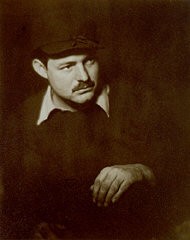
-
Cover of A Farewell to Arms
PhotoCover of Ernest Hemingway's A Farewell to Arms. (1929 cover. Princeton University Library.) In 1933, Nazi students at more than 30 German universities pillaged libraries in search of books they considered to be "un-German." Among the literary and political writings they threw into the flames during the book burning were the works of Ernest Hemingway.

-
Hemingway on a safari
PhotoAmerican novelist Ernest Hemingway on safari, ca. 1933. In 1933, Nazi students at more than 30 German universities pillaged libraries in search of books they considered to be "un-German." Among the literary and political writings they threw into the flames were the works of Ernest Hemingway.

-
Ernest Hemingway
PhotoAuthor Ernest Hemingway aboard the boat Pilar, ca. 1950. In 1933, Nazi students at more than 30 German universities pillaged libraries in search of books they considered to be "un-German." Among the literary and political writings they threw into the flames were the works of Ernest Hemingway.
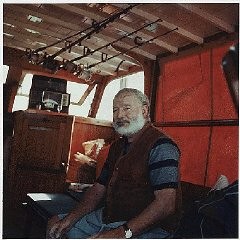
-
Henrietta and Herman Goslinski
PhotoIn 1942, Henrietta and Herman Goslinski went into hiding to avoid deportation from the Netherlands. Their rescuer could not, however, also take their infant daughter Berty. The Dutch resistance moved Berty frequently; she was eventually moved more than 30 times. During the two-and-a-half years apart, the parents saw Berty only once and received this single photograph of her taken while she was in hiding.

-
US troops view corpses of prisoners massacred by SS guards
PhotoUS troops view corpses of prisoners massacred by SS guards in a wooded area near the Kaufering IV subsidiary camp of the Dachau concentration camp. Landsberg- Kaufering, Germany, April 30, 1945.
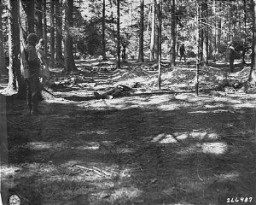
-
Torchlight parade in honor of Hitler's appointment as chancellor
PhotoAdolf Hitler, Wilhelm Frick, and Hermann Göring wave to a torchlight parade in honor of Hitler's appointment as chancellor. Behind Göring stands Rudolf Hess. Berlin, Germany, January 30, 1933.

-
Babi Yar massacre
PhotoOn September 29-30, 1941, SS and German police units and their auxiliaries, under guidance of members of Einsatzgruppe C, murdered the Jewish population of Kiev at Babi Yar, a ravine northwest of the city. This photograph shows groups of Jews being forced to hand over their possessions and undress before being shot in the ravine.
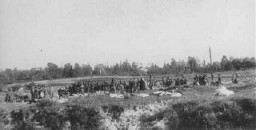
-
Soviet soldiers guard the entrance to Hitler's underground bunker
PhotoSoviet soldiers guard the entrance to Adolf Hitler's underground bunker. Upon the advance of Soviet forces through the streets of Berlin, Hitler committed suicide here on April 30, 1945, rather than face capture. Berlin, Germany, 1945.

-
Boxcars containing bodies of victims outside the Dachau camp
PhotoUS soldiers discovered these boxcars loaded with dead prisoners outside the Dachau camp. Here, they force German boys—believed to be members of the Hitler Youth (Hitlerjugend; HJ)—to view the atrocity. Dachau, Germany, April 30, 1945.
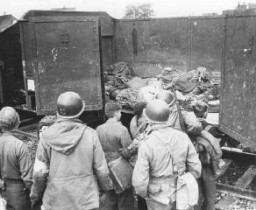
-
Cover of a work by Sigmund Freud
PhotoSigmund Freud: Massenpsychologie und Ich-Analyse, cover. In 1933, Nazi students at more than 30 German universities pillaged libraries in search of books they considered to be "un-German." Among the literary and political writings they threw into the flames were all the works of Sigmund Freud that were published by 1933.
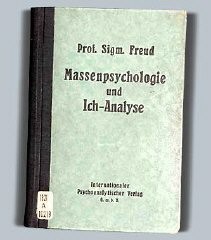
-
Symbolic groundbreaking ceremony
PhotoMembers of the United States Holocaust Memorial Council pose with two milkcans containing a Scroll of Remembrance signed by Holocaust survivors at a symbolic groundbreaking ceremony for the United States Holocaust Memorial Museum. Benjamin Meed is second from the left. Washington, DC, April 30, 1984. During groundbreaking ceremonies in April 1985, the containers were buried on the site of the Museum.
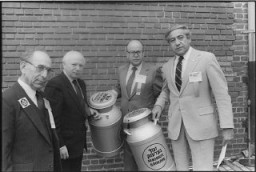
-
Aftermath of pogrom in Iasi
PhotoRoma (Gypsies) remove bodies from the Iasi-Calarasi death train during its stop in Tirgu-Frumos. Two trains left Iasi on June 30, 1941, bearing survivors of the pogrom that took place in Iasi on June 28-29. Hundreds of Jews died on the transports aboard crowded, unventilated freight cars in the heat of summer. Romania, July 1, 1941.
